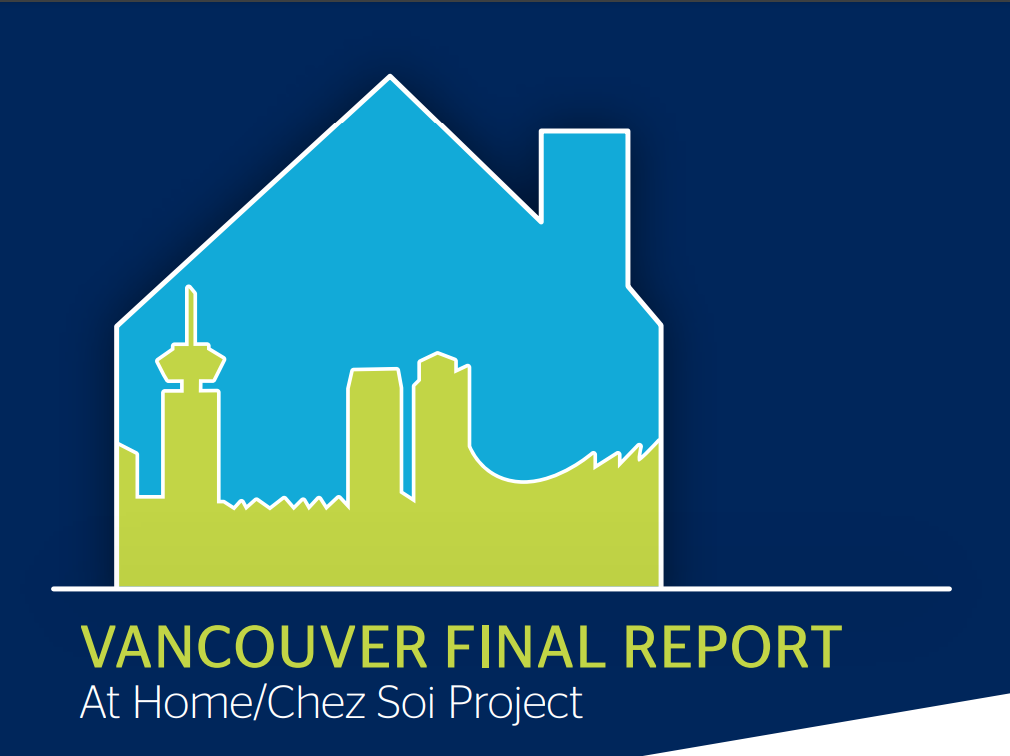If you are in distress, you can call or text 988 at any time. If it is an emergency, call 9-1-1 or go to your local emergency department.
- Reports, Research
Vancouver Final Report: At Home/Chez Soi project
This report documents the final results of the At Home/Chez Soi Vancouver site’s research demonstration project, which examined Housing First as a means of ending homelessness for people who are living with mental illness, with a particular focus on those who also had challenges with substance use. The project followed 497 participants for 8 years and compared Housing First to available local services. In contrast to the affluence and physical beauty of its surroundings, Vancouver’s Downtown Eastside (DTES) neighbourhood is among Canada’s poorest communities. The homeless population in Vancouver is concentrated in the DTES, where the city’s lowest cost rental units exist alongside a large but fragmented array of resources, including shelters, drop-in centres, and community health services. The Vancouver At Home (VAH) study is part of the national At Home/Chez Soi project investigating solutions to homelessness among people with mental illness. This report summarizes the results to date from VAH, including analyses based on narrative interviews, questionnaires, and administrative data sources. 1) VAH recruited and retained individuals with multiple challenges and needs. The VAH sample included 497 participants recruited from a wide variety of community and institutional settings, including emergency homeless shelters, local hospitals, drop-in centres, and community outreach. 78% of participants were absolutely homeless at the time of recruitment and 22% were precariously housed. Nearly three-quarters (72%) of participants were male, most were born in Canada (87%) of either European (57%) or Aboriginal (15%) descent, and the median age was 41 years. On average, participants had their first experience of homelessness when they were 30 years old, and had experienced homelessness for about three years of their lives. Psychotic disorder was the most prevalent mental illness (53%), over half of participants met criteria for two or more mental health problems or illnesses (52%), and most reported two or more physical illnesses (81%). One-third (37%) of participants reported childhood learning difficulties, nearly two-thirds (65%) had experienced traumatic head injuries, and participants reported high levels of serious adverse events in childhood such as sexual, physical, or emotional abuse, and family dysfunction. Substance dependence was observed among 58% of the participants with 29% reporting daily illicit drug use. Despite the transient nature of homeless populations and the complex challenges faced by our participants, our overall follow-up rate for the full sample was 82% with 90% follow-up in the Housing First (HF) groups and 75% in the treatment as usual (TAU) groups. 2) Housing First is a viable intervention for people experiencing chronic homelessness in Vancouver. Housing stability outcomes were significantly better for participants assigned to HF compared to TAU. Further, HF was equally effective in achieving stable housing for participants with and without substance dependence. Of the comparatively small proportion of the TAU group who received some stable housing, the quality of their accommodations was significantly worse than the quality of HF apartments. 3) Housing First impacts the use of health, social, and justice system services. Within the high needs (HN) group, 1 year after entering the study, administrative data shows that participants in TAU were visiting emergency departments roughly 7x per person, while in HF, the number of emergency department visits per person was about 3.5. Over 24 months, HF participants reported higher average use of outpatient services and lower average use of acute services compared to TAU. Prior to VAH involvement, the majority of participants had histories of involvement with the criminal justice system; following enrollment in VAH among HN participants, administrative data analysis showed that HF resulted in significantly fewer criminal convictions compared to TAU. 4) Housing First achieves positive outcomes in quality of life and community functioning in diverse neighbourhoods. Significant and meaningful improvements in community functioning and quality of life were observed among HF participants. Over the 24-month study period, these improvements were significantly greater in HF than in TAU. 5) Housing First in Vancouver delivers economic benefits. A thorough study of changes in self-reported service use concluded that the VAH HF intervention cost $28,282 per person per year on average for HN participants, and $15,952 per person per year for moderate need (MN) participants. Over the two-year follow-up period, every $10 invested in HF services resulted in an average savings of $8.55 for HN participants. For MN participants, the intervention did not result in any offset, but the additional cost for every $10 invested in HF services was very small at $1.67. 6) VAH results have important and practical policy implications. Our findings demonstrate the effectiveness of HF in improving health, housing stability, public safety, and quality of life for people experiencing homelessness, and support the implementation of HF in the Vancouver context.This resource was published in 2014. The data may be out of date.
Main Messages
- Reports, Research
Vancouver Final Report: At Home/Chez Soi project
Vancouver Final Report: At Home/Chez Soi project
- Housing and Homelessness
This report documents the final results of the At Home/Chez Soi Vancouver site’s research demonstration project, which examined Housing First as a means of ending homelessness for people who are living with mental illness, with a particular focus on those who also had challenges with substance use. The project followed 497 participants for 8 years and compared Housing First to available local services. In contrast to the affluence and physical beauty of its surroundings, Vancouver’s Downtown Eastside (DTES) neighbourhood is among Canada’s poorest communities. The homeless population in Vancouver is concentrated in the DTES, where the city’s lowest cost rental units exist alongside a large but fragmented array of resources, including shelters, drop-in centres, and community health services. The Vancouver At Home (VAH) study is part of the national At Home/Chez Soi project investigating solutions to homelessness among people with mental illness. This report summarizes the results to date from VAH, including analyses based on narrative interviews, questionnaires, and administrative data sources. 1) VAH recruited and retained individuals with multiple challenges and needs. The VAH sample included 497 participants recruited from a wide variety of community and institutional settings, including emergency homeless shelters, local hospitals, drop-in centres, and community outreach. 78% of participants were absolutely homeless at the time of recruitment and 22% were precariously housed. Nearly three-quarters (72%) of participants were male, most were born in Canada (87%) of either European (57%) or Aboriginal (15%) descent, and the median age was 41 years. On average, participants had their first experience of homelessness when they were 30 years old, and had experienced homelessness for about three years of their lives. Psychotic disorder was the most prevalent mental illness (53%), over half of participants met criteria for two or more mental health problems or illnesses (52%), and most reported two or more physical illnesses (81%). One-third (37%) of participants reported childhood learning difficulties, nearly two-thirds (65%) had experienced traumatic head injuries, and participants reported high levels of serious adverse events in childhood such as sexual, physical, or emotional abuse, and family dysfunction. Substance dependence was observed among 58% of the participants with 29% reporting daily illicit drug use. Despite the transient nature of homeless populations and the complex challenges faced by our participants, our overall follow-up rate for the full sample was 82% with 90% follow-up in the Housing First (HF) groups and 75% in the treatment as usual (TAU) groups. 2) Housing First is a viable intervention for people experiencing chronic homelessness in Vancouver. Housing stability outcomes were significantly better for participants assigned to HF compared to TAU. Further, HF was equally effective in achieving stable housing for participants with and without substance dependence. Of the comparatively small proportion of the TAU group who received some stable housing, the quality of their accommodations was significantly worse than the quality of HF apartments. 3) Housing First impacts the use of health, social, and justice system services. Within the high needs (HN) group, 1 year after entering the study, administrative data shows that participants in TAU were visiting emergency departments roughly 7x per person, while in HF, the number of emergency department visits per person was about 3.5. Over 24 months, HF participants reported higher average use of outpatient services and lower average use of acute services compared to TAU. Prior to VAH involvement, the majority of participants had histories of involvement with the criminal justice system; following enrollment in VAH among HN participants, administrative data analysis showed that HF resulted in significantly fewer criminal convictions compared to TAU. 4) Housing First achieves positive outcomes in quality of life and community functioning in diverse neighbourhoods. Significant and meaningful improvements in community functioning and quality of life were observed among HF participants. Over the 24-month study period, these improvements were significantly greater in HF than in TAU. 5) Housing First in Vancouver delivers economic benefits. A thorough study of changes in self-reported service use concluded that the VAH HF intervention cost $28,282 per person per year on average for HN participants, and $15,952 per person per year for moderate need (MN) participants. Over the two-year follow-up period, every $10 invested in HF services resulted in an average savings of $8.55 for HN participants. For MN participants, the intervention did not result in any offset, but the additional cost for every $10 invested in HF services was very small at $1.67. 6) VAH results have important and practical policy implications. Our findings demonstrate the effectiveness of HF in improving health, housing stability, public safety, and quality of life for people experiencing homelessness, and support the implementation of HF in the Vancouver context.
This resource was published in 2014. The data may be out of date.
Main Messages
SHARE THIS PAGE
RELATED

Review our Assessment Framework for Mental Health Apps — a national framework containing key standards for safe, quality, and effective mental health apps in Canada.

To help expand the use of e-mental health services, we developed four online learning modules based on our Toolkit for E-Mental Health Implementation, in collaboration with the Centre for Addiction and Mental Health (CAMH).

Stepped Care 2.0© (SC2.0) is a transformative model for organizing and delivering evidence-informed mental health and substance use services.

